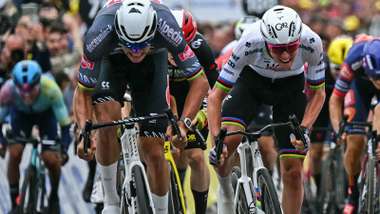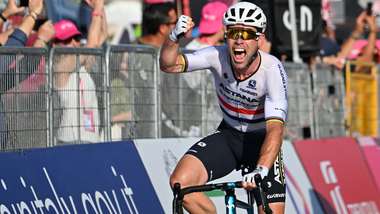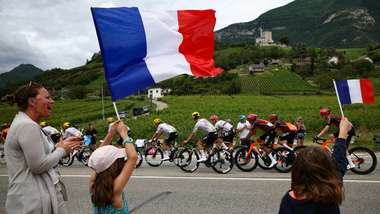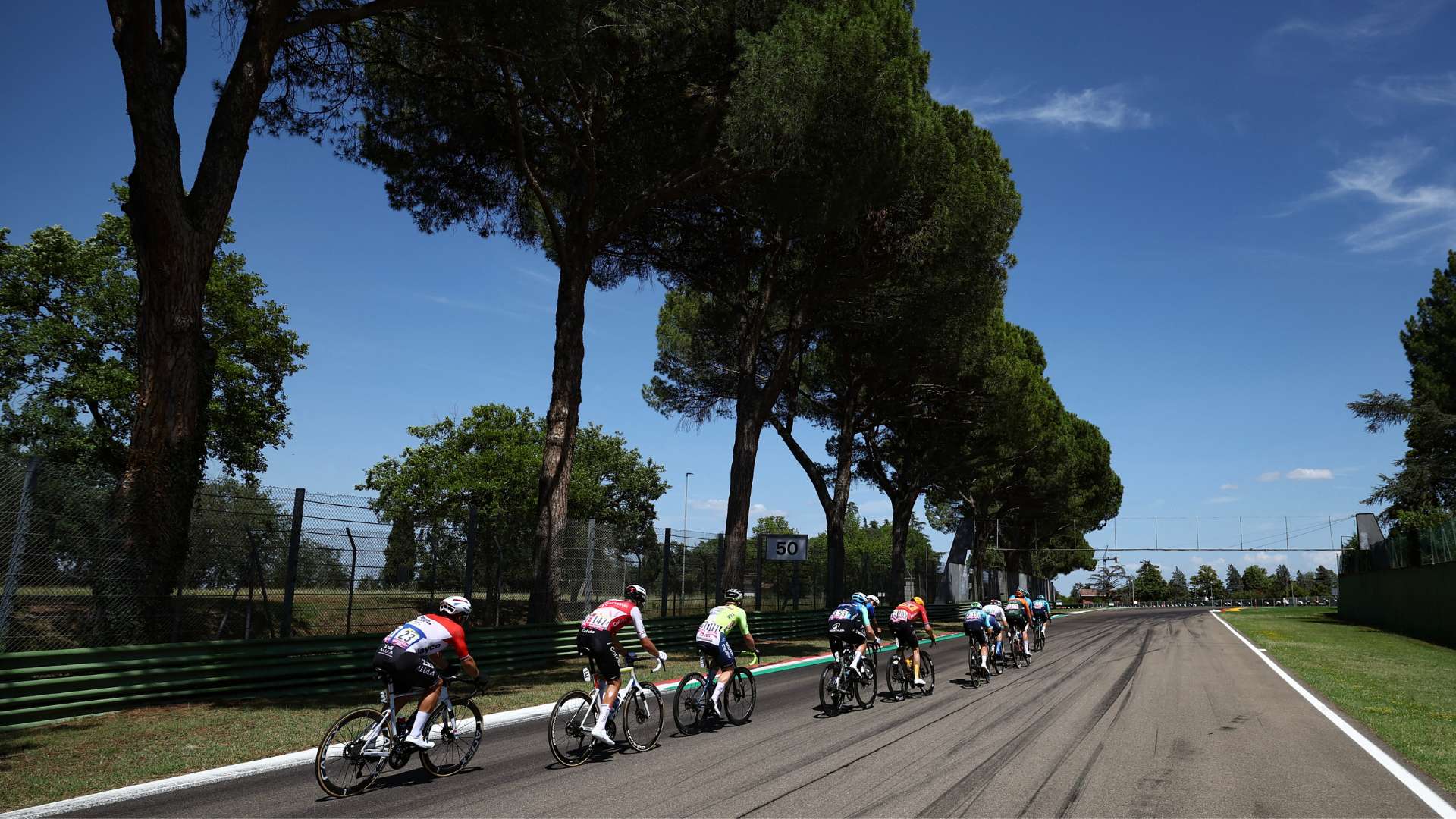Over three weeks, we'll watch the Tour de France unfold. Wrapping through some of the country's most gruelling routes, hills and time trials, 22 teams will go through thousands of kilometres to win the trophy and most-wanted maillot jaune in Paris.
Each year, the 3,300-kilometre route is carefully crafted to challenge riders with a diverse array of terrains, from flat sprints to punishing mountain climbs in the Alps and Pyrenees. Winding through picturesque French villages, iconic cities, and stunning natural vistas, stages are designed to test different cycling skills.
If you're tuning in, you can expect to see time trials, team time trials, and varying lengths of road races where past winners and new contenders alike will move up and down the ranks. In recent years, we've seen routes enter into nearby bordering countries, but 2025's race will be held in France alone, starting in Lille and working its way all the way to the capital, Paris.
For cycling enthusiasts and casual fans alike, understanding the Tour de France route is key to appreciating the strategic decisions made by teams and individual riders as they vie for the coveted yellow jersey. Here's everything you need to know.
When is the Tour de France 2025?
The 112th edition of the Tour de France 2025 takes place from July 5 to 27 and features 21 stages with an accumulated elevation of 52,500m.
The 21 days consist of seven flat, six hilly and six mountain stages, plus two time trials. The riders stay in the north of France during the first week, they tackle the Pyrenees during the second week and hit the Alps during the third.
The race will feature five summit finishes, including the famous and intimidating Mont Ventoux.
What is the route for the Tour de France 2025?
Covering approximately 3,320 kilometres over 21 stages, this year’s race carves a uniquely French path, starting in Lille and concluding in the heart of Paris on the iconic Champs-Élysées. With summit finishes at legendary climbs like Mont Ventoux, Hautacam, and Col de la Loze, the 2025 Tour is tailored for climbers and contenders looking to etch their names into cycling history.
The route features a dynamic mix of flat sprints, punishing mountain climbs, and two pivotal time trials - including a rare mountain time trial - making it a true test of all-around cycling excellence. Take a look at the table below to see exactly where the riders will be going, including stages, distance and type.
| Date | Stage | Distance | Type | Time (ET) | Streaming |
|---|---|---|---|---|---|
| Sat July 5 | 1: Lille to Lille | 185km | Flat | 6:30am | Peacock/NBC |
| Sun July 6 | 2: Lauwin-Planque to Boulogne-sur-Mer | 212km | Hilly | 6am | Peacock |
| Mon July 7 | 3: Valenciennes to Dunkirk | 178km | Flat | 6:30am | Peacock |
| Tue July 8 | 4: Amiens to Rouen | 173km | Hilly | 6:30am | Peacock |
| Wed July 9 | 5: Caen to Caen | 33km | Time trial | 6:30am | Peacock |
| Thu July 10 | 6: Bayeux to Vire Normandie | 201km | Hilly | 6am | Peacock |
| Fri July 11 | 7: Saint-Malo to Guerledan | 194km | Hilly | 6am | Peacock |
| Sat July 12 | 8: Saint-Meen-le-Grand to Laval | 174km | Flat | 6:30am | Peacock |
| Sun July 13 | 9: Chinon to Chateauroux | 170km | Flat | 6:30am | Peacock |
| Mon July 14 | 10: Ennezat to Le Mont-Dore | 163km | Mountain | 6:30am | Peacock |
| Wed July 16 | 11: Toulouse to Toulouse | 154km | Flat | 6:30am | Peacock |
| Thu July 17 | 12: Auch to Hautacam | 181km | Mountain | 6:30am | Peacock |
| Fri July 18 | 13: Loudenvielle to Peyragudes | 11km | Time trial | 6:30am | Peacock |
| Sat July 19 | 14: Pau to Luchon-Superbagneres | 183km | Mountain | 6am | Peacock |
| Sun July 20 | 15: Muret to Carcassonne | 169km | Hilly | 6:30am | Peacock |
| Tue July 22 | 16: Montpellier to Mont Ventoux | 172km | Mountain | 6am | Peacock |
| Wed July 23 | 17: Bollene to Valence | 161km | Flat | 7am | Peacock |
| Thu July 24 | 18: Vif to Courchevel | 171km | Mountain | 6am | Peacock |
| Fri July 25 | 19: Albertville to La Plagne | 130km | Mountain | 7am | Peacock |
| Sat July 26 | 20: Nantua to Pontarlier | 185km | Hilly | 6am | Peacock/NBC |
| Sun July 27 | 21: Mantes-la-Ville to Paris | 120km | Flat | 9:30am | Peacock |
Does the Tour de France route change every year?
 getty
gettyThe Tour de France route changes every year - and many fans will agree that it's one of the most exciting aspects of the race, which is meticulously designed each year to highlight different regions of France.
This annual tradition keeps the race fresh and challenging for cyclists and also serves as a showcase of France's landscape. From the sun-drenched lavender fields of Provence to the rugged peaks of the Pyrenees, each edition of the Tour takes spectators on a visual journey through the country.
This rotating route strategy not only promotes tourism in lesser-known areas but also allows cycling enthusiasts from all over the world to experience the unique charm of various French regions, making the Tour de France as much a celebration of French culture as it is a sporting event.
How is the Tour de France route selected?
The Tour de France route is selected by the race organisers, primarily Amaury Sport Organisation (ASO). Each year, the route varies, showcasing different regions of France and occasionally neighbouring countries.
This year, in 2025, the race will be held solely in France, which hasn't happened since 2020.
The selection process involves balancing various terrains, including flat stages, mountainous climbs, and time trials, to test the riders' versatility. The organisers also consider logistical aspects, such as road conditions and accommodations, while aiming to highlight the scenic and cultural landmarks of the regions. The route is usually announced several months before the race in November, generating excitement and anticipation among fans and participants.
How long is the Tour de France route?
 Getty Images
Getty ImagesThe Tour de France route typically spans approximately 3,500 kilometres (about 2,200 miles), although the exact distance can vary each year.
The race is divided into 21 stages, including a mix of flat, hilly, and mountainous terrains, as well as individual and team time trials. The length and difficulty of each stage can differ, with some stages covering over 200 kilometres in a single day. The race lasts for about three weeks, with two rest days interspersed to allow riders to recover.
Where to stay for Tour de France?
When planning to attend the Tour de France, choosing the right accommodation depends on which stages you plan to watch. Many spectators opt to stay in major cities or towns near the start or finish lines of particular stages. Popular choices include hotels, bed and breakfasts, and vacation rentals. For those looking to follow multiple stages, staying in a centrally located city with good transport links can be advantageous. Booking accommodations well in advance is recommended, as the event attracts large crowds, and availability can be limited.
How to watch the Tour de France 2025?
 Getty Images
Getty ImagesWatching the Tour de France can be a thrilling experience, whether in person or from afar. For those attending the race, positioning yourself along the route, especially at key points like mountain climbs or sprint finishes, offers a close-up view of the action. Many fans also gather at the start or finish lines of stages. For those watching from home, the race is broadcast live on television and streamed online by various sports networks worldwide. Coverage typically includes expert commentary, interviews, and behind-the-scenes insights, making it accessible to a global audience.
If you can't travel across the Atlantic Ocean to check out the European cycling action in person during 2025, you can always watch or stream the action live at home or on the go.
There are now three main broadcasters/streaming services offering live cycling coverage for US viewers: FloBikes, Max and Peacock. Peacock (NBC’s streaming service) will be showing all 21 stages of the Tour de France 2025 live, broadcasting from 6/6:30am (ET) on most days with pre-race shows. NBC will also be screening live coverage of stages 1 and 20 and showing highlights of stages 2, 15, 20 and 21.
You’ll only need Peacock Premium to catch all the action, which costs just $7.99 per month (or $80 annually for ad-supported streaming). For fans looking to catch the Tour de France and tag it onto a great sports package, Fubo is one of the best streaming services around. Fubo packages start from $79.99 a month, and they offer all-inclusive free 7-day trials before you pay. Fubo’s massive streaming plans carry up to 200+ channels, and you can get even more depending on your location. For avid sports fans, Fubo is the ultimate choice as it also provides access to other popular sports, including NFL, NBA, MLB, NHL & MLS. International soccer fans can also enjoy some of the world’s best leagues, such as the Premier League and La Liga. Most Fubo plans allow you to stream on up to 10 devices simultaneously.
Where to fly for Tour de France?
The choice of airport for flying to the Tour de France depends on which stages you plan to attend. Major international airports such as Paris Charles de Gaulle, Lyon-Saint Exupéry, and Nice Côte d'Azur are popular entry points, offering good connections to various parts of France.
From these airports, domestic flights, trains, or car rentals can be used to reach specific locations along the race route. Planning your travel itinerary is crucial, as the event attracts many visitors, and transportation options may be in high demand.



